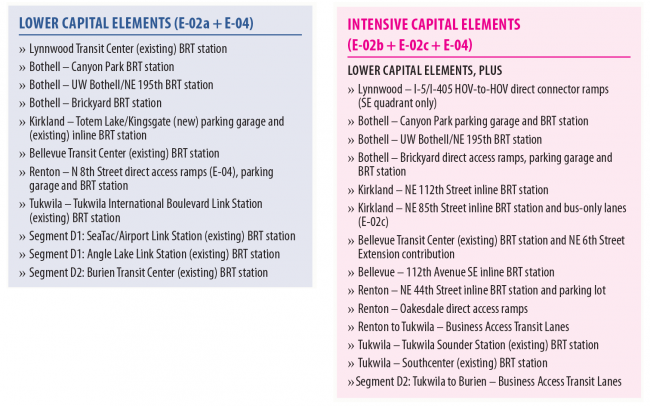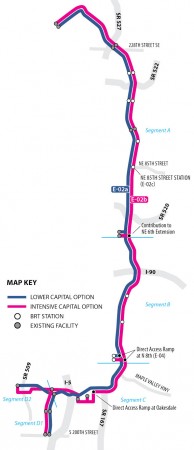ST3: Bus Rapid Transit on I-405
There has long been a regional consensus that I-405 Bus Rapid Transit would be a part of the ST3 program. But that general agreement has hidden a fuzziness about the form it would take. The December 4 workshop saw a range of options presented. The studies make a compelling case for a low-cost version of I-405 BRT, but complicate the case for doing much more. The eye-popping conclusion is that a range of investment levels between $340 million and $2.3 billion all produce the same ridership.
Staff presented "low capital" and "intensive capital" representative models. In between are a long list of a la carte options. There are two alternatives for a southern terminus; one at Angle Lake, the other at Burien TC. The "low capital" model leans heavily on existing infrastructure, and is less ambitious than any of the options examined in the previous set of studies in 2014.
Low Capital BRTStaff analysis helpfully breaks out cost and performance by segment. Segment A, Lynnwood TC to Bellevue TC, is the most productive with up to 10,000 riders, about 60% of all the ridership on the BRT. 10 of the 19 miles are served via general purpose lanes on I-5 and I-405 (other than limited shoulder-running southbound on I-405). Only the portion between Brickyard and Bellevue can be served via HOT lanes. Segment B, Bellevue to Renton, runs entirely in HOT lanes, but achieves fewer than 1,500 riders. That would include a deferred project to build HOV direct access ramps at N 8th St in Renton.
Beyond Renton, there is little new investment. Segment C, Renton to Tukwila International Boulevard Link Station, would run in HOT lanes on I-405 and general purpose lanes on SR 518, achieving a respectable 3,500 riders with little cost other than vehicles. From TIBS, the service could continue to Angle Lake via BAT lanes on SR 99 (Segment D1), or to Burien Transit Center via general purpose lanes on SR 518 (Segment D2).
The total capital cost under $350 million is modest for the ridership, mostly because the highway infrastructure is largely existing or funded through WSDOT. 28% of the cost is for parking.
The 'intensive capital' option adds several stations and upgrades others. It eliminates much of the interaction with general purpose lanes via added ramps in the north and BAT lanes in the south.
Segment A sees added HOV ramps from I-5 to I-405 and station upgrades along I-405. This gets the BRT out of general purpose lanes except between Canyon Park and UW Bothell. Segment B is in HOT lanes in either proposal. To the south, general purpose segments on SR 518 would be eliminated. Segment C, D1 and D2 would all shift to BAT lanes on arterial streets.
There are up to six additional stops. Two are in Kirkland; at NE 112th St (the southern part of Totem Lake) and at NE 85th St (near downtown). Two more are between Bellevue and Renton; at 112th Avenue SE (adjacent to the Newport Hills Park-and-Ride which would be expanded) and NE 44th Street in Renton. The realignment of Segment C from SR 518 adds service to Tukwila Sounder Station and Southcenter. Other stations all along the corridor see added parking and direct access ramps.
Downtown Kirkland gets close attention. The NE 85th flyer stop is estimated at up to $260 million, lower than the 2014 study because the station footprint has been reduced and parking eliminated. But there is another $105 million for bus lanes to downtown Kirkland and on 85th St, much of that for property acquisition. The cost and disruption may be too great to stack up against alternatives serving central Kirkland directly.
The OutlookRemarkably, the intensive capital investments produce no net additional ridership. Ridership increases on some segments, but the five-minute time penalty offsets this for through-travel. Eastside leaders view these results skeptically. How can six additional stations and improved reliability, with such a minimal travel time penalty, not yield more ridership? The added stations have mostly poor land use and TOD potential. Other than the Bellevue CBD, I-405 serves generally weak transit destinations, with urban centers at some remove from the highway. There may be diminishing returns to transit access via park-and-rides. How useful is a second P&R within easy driving distance?
While the poor modeled performance of the intensive capital option will be questioned, it likely means that the extra stations go to the end of the queue for funding.

